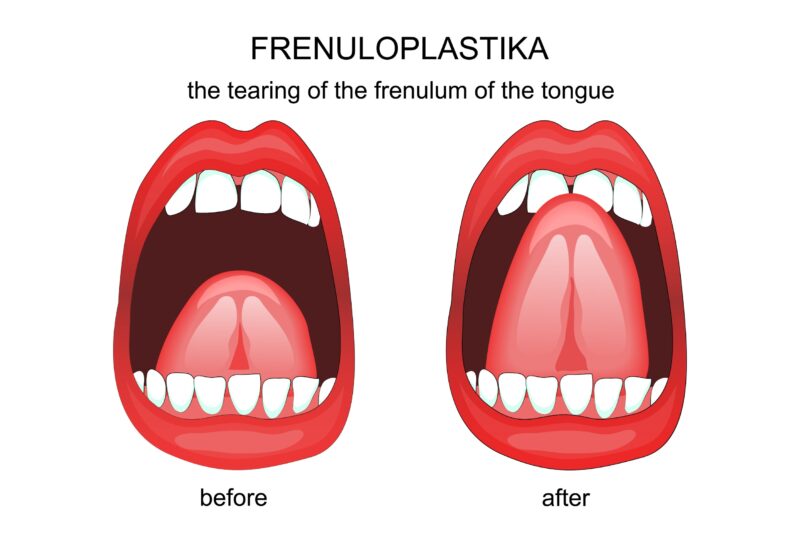PEDIATRIC FRANECTOMY
WHAT IS A FRENECTOMY?

HAVE QUESTIONS ABOUT WHAT PEDIATRIC FRENECTOMY IS? FIND ANSWERS HERE
WHAT IS A FRENECTOMY?
A frenectomy is a surgical procedure that involves the removal or modification of a frenum, a small piece of tissue that connects two parts of the body.
WHAT IS A PEDIATRIC FRENECTOMY?
A pediatric frenectomy is a frenectomy procedure performed on infants or children who have a tight or abnormal frenum that is causing difficulty with breastfeeding, speech, or other oral functions.
WHAT ARE THE TYPES OF FRENECTOMY?
There are three types of frenectomy: lingual frenectomy, labial frenectomy, and buccal frenectomy. Lingual frenectomy involves removing or modifying the frenum that connects the tongue to the floor of the mouth, while labial frenectomy involves removing or modifying the frenum that connects the upper lip to the gums. Buccal frenectomy involves removing or modifying the frenum that connects the cheeks to the gums.
WHAT ARE THE INDICATIONS FOR A PEDIATRIC FRENECTOMY?
The indications for a pediatric frenectomy include difficulty with breastfeeding, speech impediments, dental problems such as spacing between the teeth, and other oral functions that are affected by a tight or abnormal frenum.
HAVE QUESTIONS ABOUT WHAT THE PROCEDURE FOR A PEDIATRIC FRENECTOMY IS? FIND ANSWERS HERE
WHAT IS THE PROCEDURE FOR A PEDIATRIC FRENECTOMY?
The procedure for a pediatric frenectomy involves numbing the area with a local anesthetic, making a small incision in the frenum, and then removing or modifying the frenum tissue. The procedure is usually quick and relatively painless.
ARE THERE ANY RISKS ASSOCIATED WITH A PEDIATRIC FRENECTOMY?
Like any surgical procedure, there are some risks associated with a pediatric frenectomy, such as bleeding, infection, and damage to surrounding tissues. However, these risks are rare, and the procedure is generally considered safe.
HOW LONG DOES THE PROCEDURE TAKE?
The procedure typically takes about 15 to 30 minutes to complete, although the exact length of time may vary depending on the type and severity of the frenum.
IS SEDATION OR GENERAL ANESTHESIA NECESSARY FOR A PEDIATRIC FRENECTOMY?
Sedation or general anesthesia is not usually necessary for a pediatric frenectomy, as the procedure is typically performed using a local anesthetic to numb the area.
CAN A PEDIATRIC FRENECTOMY BE DONE IN A DENTIST’S OFFICE?
Yes, a pediatric frenectomy can be done in a dentist’s office, as long as the dentist has the necessary training and equipment to perform the procedure safely and effectively.
WILL MY CHILD NEED STITCHES AFTER THE PROCEDURE?
It depends on the type of frenectomy and the size of the incision. In some cases, stitches may be necessary to close the incision, while in other cases, the incision may be left to heal on its own. Your dentist or surgeon will be able to advise you on the appropriate aftercare and follow-up.
HAVE QUESTIONS ABOUT THE RECOVERY PROCESS FOR PEDIATRIC FRENECTOMY? FIND ANSWERS HERE
WHAT IS THE RECOVERY PROCESS LIKE FOR A PEDIATRIC FRENECTOMY?
The recovery process for a pediatric frenectomy is usually quick and straightforward. The child may experience some discomfort for a day or two after the procedure, but they can typically resume their normal activities within a few days
HOW SOON AFTER A PEDIATRIC FRENECTOMY CAN MY CHILD BREASTFEED OR EAT?
Your dentist or surgeon will give you specific instructions on when your child can resume feeding and eating after the procedure. In most cases, children can resume breastfeeding or eating within a few hours after the procedure, although they may experience some discomfort or soreness for a day or two afterward.
WILL MY CHILD NEED TO FOLLOW ANY SPECIAL AFTERCARE INSTRUCTIONS?
Yes, your dentist or surgeon will give you specific aftercare instructions to follow after the procedure, such as how to clean the incision site and what types of foods to avoid.
There’s a Horizon of Smiles Ahead
LET’S STAY IN TOUCH
Phone
Call: (858) 215-2485
Text: (858) 282-0085
Fax: (858) 905 3385
Address
13350 Camino Del Sur
Suite 3B
San Diego, CA 92129
team@sunraypediatricdentistry.com
Hours
MON: 8:00am – 6:00pm
TUES: 8:00am – 6:00pm
WED: 8:00am – 4:00pm
THU: 8:00am – 4:30pm
FRI: 7:00am – 4:00pm







